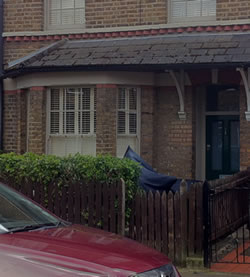No Blue Plaque For Anthony Burgess' Chiswick Home
Clockwork Orange author spent 5 years in Glebe Street
|
The Glebe Street home where writer Anthony Burgess spent the 1960s will not receive a commemorative plaque this year, English Heritage has decided.
Burgess is most famous for his novel A Clockwork Orange, a dystopian take on teenage delinquency which was adapted into a controversial film by Stanley Kubrick.
He moved with his first wife Lynne to 24 Glebe Street in 1963, the year after Clockwork was published, and stayed there for five years, writing 6 novels, 3 books of criticism and several translations in his Chiswick period. A few months after Lynne's death in March 1968, Burgess left West London and England for good.

(Writer Anthony Burgess, image courtesy of anthonyburgess.org)
The period of his residence in W4 was a time of great creativity for Burgess. He wrote several of his most important novels in Chiswick, including Nothing Like the Sun (a fictional life of Shakespeare, written in Elizabethan English), Tremor of Intent (a spy thriller in the style of Ian Fleming) and Enderby Outside, a comic sequel.
He was also composing piano music at this time, and in 1968 he wrote the script, lyrics and music for an unmade Hollywood musical about Shakespeare, under the working title "The Bawdy Bard". Finally, Burgess began work on a slang dictionary in 1967, commissioned by Penguin Books. The incomplete manuscript of this work has recently been discovered in Manchester, but is yet to be published.
Burgess often wrote about the places where he lived, and Chiswick is no exception. Glebe Street is one of the locations used by Burgess in Tremor of Intent, while Burgess also included an affectionate account of his years here in the second volume of his autobiography. Burgess formed part of a lively literary circle in W4, and frequented local pubs with the likes of Kingsley Amis.

(24 Glebe Street, a setting for Burgess' 1966 spy novel Tremor of Intent)
Last December, the Manchester-based Anthony Burgess Foundation received news from English Heritage that its Blue Plaques Panel had decided not to shortlist the writer for commemoration. It was deemed that Burgess' legacy, 20 years after his death, was not yet strong enough to receive a blue plaque.
However, the Panel did not discount the possibility of Glebe Street receiving a commemorative roundel for its famous resident in the future. Indeed, the Panel added a recommendation that Burgess could be re-nominated after only five years, rather than the usual ten, in the expectation that new work on Burgess would be published 'in the interim'.
Professor Andrew Biswell, Director of the Anthony Burgess Foundation, commented: "Anthony Burgess was a true giant of twentieth-century literature and music. His books are still read all over the world. In his lifetime, Burgess was awarded public honours by France and Monaco, but he received no honours from the British state."
He continued, saying that though the Foundation was "very pleased" that Burgess had already been given a plaque in Manchester, the city where he was born and raised, "it is disappointing that there is no memorial" to the writer in London. Biswell also expressed a hope that the schedule for the 2017 centenary of Burgess' birth, including new editions of his poetry and music concerts, will make English Heritage reconsider their decision.
April 1, 2015